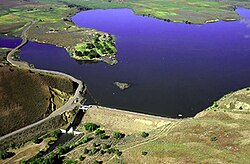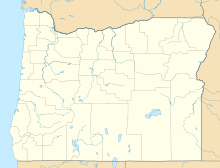| Unity Lake State Recreation Site | |
|---|---|
 Unity Dam and Unity Reservoir | |
| Type | Public, state |
| Location | Baker County, Oregon |
| Nearest city | Baker City |
| Coordinates | 44°29′56″N118°11′14″W / 44.4988889°N 118.1872222°W [1] |
| Operated by | Oregon Parks and Recreation Department |
Unity Lake State Recreation Site is a state park in the U.S. state of Oregon, administered by the Oregon Parks and Recreation Department.
Contents
Unity Dam was constructed in 1938 by the United States Bureau of Reclamation as an irrigation storage project. The 82-foot (25 m) earthen dam impounds the water of the Burnt River to create Unity Reservoir, originally with 27,000 acre-feet (33,000,000 m3) of capacity. [2] No hydroelectric power is generated here. The project is owned by the Bureau, and operated and maintained by the local Burnt River Irrigation District.
Facilities at the adjacent state park include cabins, camp sites, day-use parking and boat ramps. [3]

